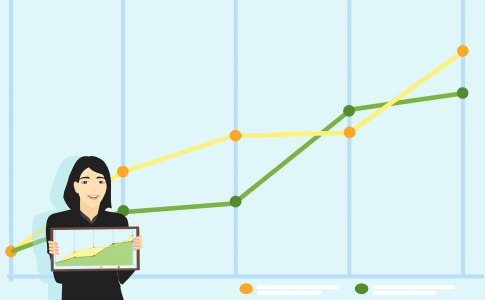Should you be concerned with the bounce rate of your website?
Yes. Definitely!
It is an important metric that not only tells you about a possible SEO impact of your website in the near future, but it also explains a lot about your website’s “stickiness”, engagement level, and quality of content.
In this blog post, we are going to discuss a lot of important concepts about bounce rates. In the next five minutes of reading this blog post, you will learn probably everything that you should know about the bounce rate of your website.
Ready?
Let’s get started.
What is a Bounce Rate?

Many webmasters and content marketers often confuse the term “bounce rate” with “exit rate”. These two terms are very different from each other and carry different meanings and, therefore, should not be confused.
The bounce rate of your website shows the percentage of visitors who land on a webpage and then quit your website without clicking any other link.
On the other hand, the exit rate of a website just shows people who simply quit a web page. Those visitors may have already visited other pages on your website, but the exit rate doesn’t tell you anything about that.
So, as you can see, these are two different metrics and help you analyze different aspects of your website.
What do Bounce Rates Tell You?
Now, this is tricky.
Although bounce rates have a simple enough definition, analyzing what the bounce rate of your website is telling can be a little difficult. Perhaps this is the reason why so many webmasters fail to read it and improve their websites accordingly.
Generally speaking, a high bounce rate is bad for your website. It shows that the content — and structure — of your website is not engaging enough to hold the attention of your readers.
However, sometimes, numbers may lie.
Is High Bounce Rate Always a Bad Signal?
Most of the time, a high bounce rate doesn’t mean good news. But in some scenarios, it doesn’t mean anything. It all depends on what kind of a website you have and what its purposes are.
For instance, if you are a business website with a deep sales funnel, one of your primary content goals is to lead your readers from the top of the funnel content to the landing page. Right?
If the visitors read the first page and quit your website, they are never going to reach the end of the sales funnel. This will lead to a high bounce rate, and it indicates that your website is not fulfilling its purposes and goals.
A high bounce rate, in these circumstances, is a clear indication of a bad sign.
On the other hand, you may have a business website with the primary goal of making your visitors contact you via email or phone. In this scenario, you don’t need your visitors to click on any other page. They can get all the information they require from a single “contact page”, and they will quit right away once they have that information.
Be sure to know that you will have a high bounce rate because of it, but it won’t be a bad sign. This is because your website/web page would have fulfilled its purpose of giving them your contact information. It didn’t need them to click another link and, therefore, reduce your site’s bounce rate.
What is a Good Bounce Rate?
It always depends on the niche you are in.
In some niches, the bounce rate can go as low as 35 - 40%. Conversely, in some niches, it is not very uncommon to have a bounce rate as high as 80%.
So, all in all, it depends on the specific niche you are in.
Generally speaking, if you have a publishing website with lots of blog posts, a bounce rate of around 70% would be fine.
Benefits of a Low Bounce Rate
We can safely assume that, in almost all cases, a low bounce rate is a good sign.
But why is that? Why is a low bounce rate good for your website?
Actually, there are several benefits of having a low bounce rate. Following are some of its major benefits:
1. Low Bounce Rate = Better Engagement
If your website has a low bounce rate, it shows that your website visitors are not quitting after just reading one page. They are also clicking on other internal links and reading more posts and pages.
All of this eventually translates into better user engagement.
More user engagement means more loyal following, increased page views, more conversions, and more profits.
2. Bounce Rate and SEO
Another very important benefit of having a low bounce rate is that it helps with the SEO of your website.
As search engines are getting smarter, they are focusing more and more on user engagement for search engine ranking factors.
If search engines believe that a website is useful for its target audience, they rank it higher in the search engines. Otherwise, they penalize it and demote it in the SERPs.
This is one of the reasons why social signals and backlinks are becoming more important ranking factors, and keyword optimization is losing its value and impact.
Anyway, a high bounce rate sends negative signals to search engines. It indicates that the website visitors are not finding other content of your website engaging enough to click on them.
On the other hand, if a website has a very low bounce rate, it sends positive signals to search engines.
Search engines, such as Google, believe that the said website has a lot of useful content — which the traffic visitors find very interesting and useful. After all, a low bounce rate is an indication that they are not quitting after reading just one page. Instead, they are finding other blog posts so engaging and helpful that they are clicking on them, too.
Because of this phenomenon, search engines promote such websites with a low bounce rate, so more and more users may find those helpful content.
Final Words
Bounce rate is an important metric that you should closely inspect whenever possible.
It not only has technical SEO benefits, but it is also a good indicator of where your website is moving towards.
If you have an unreasonably higher bounce rate, it means that your content, website structure, and website navigation may have problems that should be rectified as soon as possible. A higher bounce rate is also one of the best indicators that you may need to increase the quality and engagement level of your blog’s content.
On the other hand, if your website is not a publishing website with many blog posts, it may have different goals, e.g., generating telephone leads. Such a website will have a very high bounce rate, but it won’t be a problem as it would be fulfilling its main purpose of generating leads.
If you want to know how you can reduce your website's bounce rate, read the following article.
